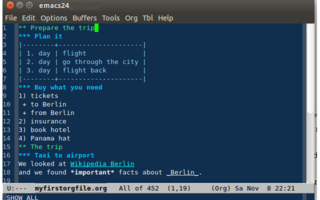
Amitābha is the principal Buddha of Pure Land Buddhism. He is also known as Amitāyus, which is understood to be his enjoyment body (Saṃbhogakāya). In Vajrayana Buddhism, Amitābha is known for his longevity, discernment, pure perception, and the purification of aggregates with deep awareness of the emptiness of all phenomena. The name Amitābha means "Infinite Light", and the name Amitāyus means "Infinite Life".
The Perseus Digital Library, formerly known as the Perseus Project, is a free-access digital library founded by Gregory Crane in 1987 and hosted by the Department of Classical Studies of Tufts University. One of the pioneers of digital libraries, its self-proclaimed mission is to make the full record of humanity available to everyone. While originally focused on the ancient Greco-Roman world, it has since diversified and offers materials in Arabic, Germanic, English Renaissance literature, 19th century American documents and Italian poetry in Latin, and has sprouted several child projects and international cooperation. The current version, Perseus 4.0, is also known as the Perseus Hopper, and is mirrored by the University of Chicago.

An outliner is a specialized type of text editor used to create and edit outlines, which are text files which have a tree structure, for organization. Textual information is contained in discrete sections called "nodes", which are arranged according to their topic–subtopic (parent–child) relationships, like the members of a family tree. When loaded into an outliner, an outline may be collapsed or expanded to display as few or as many levels as desired.

Wŏnhyo was one of the most important philosophers and commentators in East Asian Buddhism and the most prolific scholar in Korean Buddhism. As one of the most eminent scholar-monks in East Asian history, his extensive literary output runs to over 80 works in 240 fascicles. His most influential commentaries are those on buddha-nature texts like the *Vajrasamādhisūtra, the Awakening of Faith, and the Mahāparinivāṇasūtra. These works became classics widely respected throughout Korea, China and Japan.

The Sutra of Perfect Enlightenment or Complete Enlightenment is a Mahāyāna Buddhist sūtra highly esteemed by both the Huayan and Zen schools. The earliest records are in Chinese, and it is believed to be of Chinese origin.
The Eight Consciousnesses is a classification developed in the tradition of the Yogācāra school of Mahayana Buddhism. They enumerate the five sense consciousnesses, supplemented by the mental consciousness (manovijñāna), the defiled mental consciousness (kliṣṭamanovijñāna), and finally the fundamental store-house consciousness (ālāyavijñāna), which is the basis of the other seven. This eighth consciousness is said to store the impressions (vāsanāḥ) of previous experiences, which form the seeds (bīja) of future karma in this life and in the next after rebirth.
The Pāli Text Society is a text publication society founded in 1881 by Thomas William Rhys Davids "to foster and promote the study of Pāli texts." Pāli is the language in which the texts of the Theravada school of Buddhism are preserved. The Pāli texts are the oldest collection of Buddhist scriptures preserved in the language in which they were written down. The society first compiled, edited, and published Latin script versions of a large corpus of Pāli literature, including the Pāli Canon, as well as commentarial, exegetical texts, and histories. It publishes translations of many Pāli texts. It also publishes ancillary works including dictionaries, concordances, books for students of Pāli and the Journal of the Pali Text Society.

The Tathāgatagarbha sūtras are a group of Mahayana sutras that present the concept of the "womb" or "embryo" (garbha) of the tathāgata, the buddha. Every sentient being has the possibility to attain Buddhahood because of the tathāgatagarbha.
A. Charles Muller is a Japan-based academic specializing in Korean Buddhism and East Asian Yogacara, having published numerous books and articles on these topics. He was one of the earliest developers of online research resources for the field of Buddhist Studies and the founder and managing editor of the Digital Dictionary of Buddhism, the CJKV-English Dictionary, and the H-Buddhism Scholars Information Network, along with having digitized and published numerous reference works.
Dan Lusthaus is an American writer on Buddhism. He is a graduate of Temple University's Department of Religion, and is a specialist in Yogācāra. The author of several articles and books on the topic, Lusthaus has taught at UCLA, Florida State University, the University of Missouri, and in the Autumn of 2020 he was an Associate in the Department of South Asian Studies at Harvard University.
OPML is an XML format for outlines. Originally developed by UserLand Software as a native file format for the outliner application in its Radio UserLand product, it has since been adopted for other uses, the most common being to exchange lists of web feeds between web feed aggregators.
The Ijangui, or Doctrine of the Two Hindrances, is an in-depth treatise concerning the various theories developed on the doctrine of the two hindrances of the Yogācāra school of Buddhism, by the Korean scholar-monk Wonhyo. This treatise examines and compares the various explications regarding the two hindrances as found in the major Yogācāra texts, including the Yogācārabhūmi-śāstra, Saṃdhinirmocana-sūtra, Mahāyānābhidharma-samuccaya-vyākhyā, Śrīmālādevī-simhanāda-sūtra and Xianyang lun, along with a wide range of other Mahāyāna texts. For an expanded explanation, see the below link.

Awakening of Faith in the Mahāyāna is an influential Mahayana Buddhist treatise for East Asian Buddhism.
Kleshas, in Buddhism, are mental states that cloud the mind and manifest in unwholesome actions. Kleshas include states of mind such as anxiety, fear, anger, jealousy, desire, depression, etc. Contemporary translators use a variety of English words to translate the term kleshas, such as: afflictions, defilements, destructive emotions, disturbing emotions, negative emotions, mind poisons, and neuroses.
Dao'an was a Buddhist monk, author and bibliographer, during the Eastern Jin dynasty. He was from what is now Hebei. His main importance was that of overseer of translation of Buddhist texts into Chinese, organizer of the Chinese sangha, author of exegetical works and compiler of the most important early catalogue of Chinese Buddhist translation in 374. Although this catalogue is itself lost, Sengyou reproduces much of it in his catalogue (T2145) completed in 515.
Michael Beddow was a British scholar of German literature, who was also a renowned expert in the application of XML technologies to web representations of literary corpora, and who was deeply involved with the work of the Text Encoding Initiative (TEI).
ChemXSeer project, funded by the National Science Foundation, is a public integrated digital library, database, and search engine for scientific papers in chemistry. It is being developed by a multidisciplinary team of researchers at the Pennsylvania State University. ChemXSeer was conceived by Dr. Prasenjit Mitra, Dr. Lee Giles and Dr. Karl Mueller as a way to integrate the chemical scientific literature with experimental, analytical, and simulation data from different types of experimental systems. The goal of the project is to create an intelligent search and database which will provide access to relevant data to a diverse community of users who have a need for chemical information. It is hosted on the World Wide Web at the College of Information Sciences and Technology, The Pennsylvania State University.
Buddhist studies, also known as Buddhology, is the academic study of Buddhism. The term Buddhology was coined in the early 20th century by the Unitarian minister Joseph Estlin Carpenter to mean the "study of Buddhahood, the nature of the Buddha, and doctrines of a Buddha", but the terms Buddhology and Buddhist studies are generally synonymous in the contemporary context. According to William M. Johnston, in some specific contexts, Buddhology may be viewed as a subset of Buddhist studies, with a focus on Buddhist hermeneutics, exegesis, ontology and Buddha's attributes. Scholars of Buddhist studies focus on the history, culture, archaeology, arts, philology, anthropology, sociology, theology, philosophy, practices, interreligious comparative studies and other subjects related to Buddhism.
XQuery is a query and functional programming language that queries and transforms collections of structured and unstructured data, usually in the form of XML, text and with vendor-specific extensions for other data formats. The language is developed by the XML Query working group of the W3C. The work is closely coordinated with the development of XSLT by the XSL Working Group; the two groups share responsibility for XPath, which is a subset of XQuery.

Tipiṭaka or Tripiṭaka, meaning "Triple Basket", is the traditional term for ancient collections of Buddhist sacred scriptures. The Tripiṭaka is composed of three main categories of texts that collectively constitute the Buddhist canon: the Sutra Piṭaka, the Vinaya Piṭaka, and the Abhidhamma Piṭaka.





